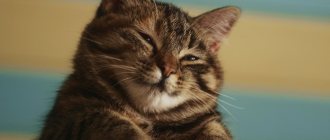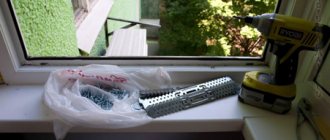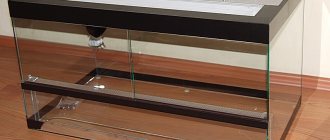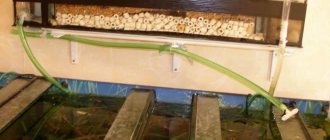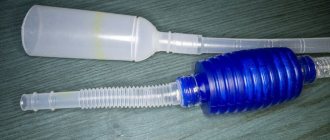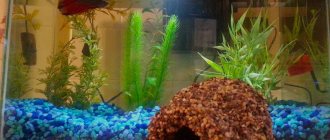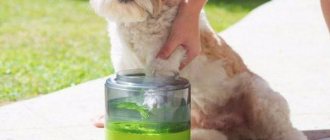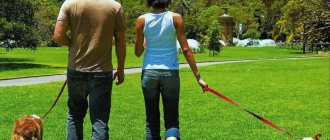DIY modern cattle feeders
Their design may vary depending on the feeding location.
Each option has its own nuances. Table 1. Features of feeders
| Feeder type | What does it look like | Peculiarities |
| Stall | It is installed on the aisle and has a fence in the form of small walls. Located at a distance of 15 cm from the floor. | — Simplifies the process of applying food; - makes cleaning easier; - does not require special skills to make with your own hands; - makes it possible to save money. |
| Pasture | This is a large capacity container that can be easily transported from one place to another. Used when walking cows in the meadow. | — Reduces time spent on maintenance; - practicality. |
Living conditions and the number of animals also need to be taken into account when choosing a feeding format. It can be automated - for a large herd, or manual - when there are 1-3 individuals in the stall
Automated livestock feeding
Description and mechanism of action
An automatic feeder is a device for feeding a cat without human presence. It is a large plastic container of various shapes and sizes, which the owner fills with dry or wet food.
A device is connected to the container that allows you to dispense a dosed amount of food to the animal. The feed supply mechanism can be varied:
- in the form of a round container with a lid, divided into segments, which are filled with food for one meal;
- trays with lids that open when signaled by a timer;
- dosed feeding of food from a large container into a bowl.
How to make level drinking bowls for cows with your own hands
Self-manufacturing of level drinking bowls will help not only save the budget, but also equip the barn in accordance with the needs of the owner, the farm and the cows kept.
Familiarize yourself with udder diseases in cows, hoof diseases in cows.
Design and dimensions
The process of manufacturing a drinking system itself will not be difficult if the farmer studies the design features and their basic operating principle. The main idea is to build a free-standing container with a valve-float-operated water supply system, which regulates the presence of liquid and its level in all drinkers. As a result, the liquid is transferred through gutters made of wood, brick or concrete.
The optimal parameters of drinking bowls for adult cows are 2255x700x1010, volume - 140 liters. Weight - up to 150 kg. The length may vary depending on the age category of the animals (1500mm–2000mm).
It is also important to consider the following points:
- the upper side of the drinking container should be at least 8 cm away from the floor so that the animals do not touch the edges of the trough with their larynx and do not bend their neck too much while drinking;
- with loose housing, water containers should be placed no further than 15 m from the feeders;
- To prevent cows from gathering in a tight line near the drinking bowls, they must be placed at different ends of the barn according to their calculation - 25 cows per 1 container at a filling speed of 15 liters per minute.
Did you know? The image of a cow can be seen on the state symbols of Andorra, Nepal and a number of other countries. In India, the animal is sacred and symbolizes prosperity, harvest abundance and livestock fertility. In Hurrian mythology, the God of Thunder rode two cows - Urri (morning) and Serry (evening).
How to install automatic drinkers in a barn: video
Material and tools
Materials for drinking tanks should be selected based on the size of the barn, the number of livestock and personal preferences.
As noted above, this could be:
- metal;
- tree;
- plastic;
- brick.
Learn how to ventilate a barn. Necessary tools for assembling the drinking structure:
- drill;
- brick;
- construction ruler;
- marker;
- hammer;
- sand;
- saw;
- cement;
- welding machine;
- profile pipe.
Manufacturing stages
Metal drinking bowl:
- Weld or rivet a long rectangular iron box;
- At the very end, install a tap or folding wall (to drain the remaining water).
Important! To ensure that the folding wall is as tight as possible and seals tightly, a rubber seal is used during the manufacturing process.
From wooden boards:
- Build a container of the required size from boards;
- Cover the remaining cracks with resin;
Made of plastic:
- Purchase a rectangular plastic gutter (from 30 cm);
- Place the containers on iron “legs”.
From bricks:
- Lay out a container of bricks;
- Plaster the inside and sides with non-toxic material.
From a gas cylinder:
- Wash the gas cylinder (100 l) thoroughly, dry it and ventilate it in the air;
- Make 4 holes in the gutter: for draining, for a pipe that conducts water, for discharging water into the gutter and, of course, for the heater;
- Install a valve with a float in the tank.
Do-it-yourself automatic drinker for cows: video
Internal equipment of the barn
When the barn is built, it needs to be equipped with feeders and drinkers; make a stall and a calf bay; consider manure removal.
How to make your own feeder
Creating the right feeder is a necessary undertaking, since its use will help not waste feed unnecessarily and will be comfortable to use. So, for wet food you can prepare special plastic feeders, for grain - buckets, and for hay you can make lattice mangers made of wood or pipes with an open rectangular top, but tapering downwards.
Hay feeder
The cow will take feed from them in portions, thus preventing it from being trampled.
Important! Although many people believe that the hay that spills out of the feeder makes the litter deeper. The stationary feeder is separated from the animal by a partition and placed 70 cm from it
The height of the inner side is no more than 55-60 cm (oriented towards the cattle’s knee). The height of the outer wall is 30 cm for easy filling of the manger with food. Such elements are intended for open paddocks or stalls for mixed feed and hay. Such a product is made solid without gratings, for example from plywood or galvanized sheets
The stationary feeder is separated from the animal by a partition and placed 70 cm from it. The height of the inner side is no more than 55-60 cm (oriented towards the cattle’s knee). The height of the outer wall is 30 cm for easy filling of the manger with food. Such elements are intended for open paddocks or stalls for mixed feed and hay. Such a product is made solid without gratings, for example from plywood or galvanized sheets.
Drawing of a wooden feeder
You can make a trough-shaped feeder from half a large-diameter plastic pipe or galvanized drain installed on a frame. This design is very convenient to wash with a stream of water with good pressure. The main thing is to carefully process the cut.
Small nurseries with a width of only 5-7 cm are built for calves, since they can only have 2 kg of hay per day at the age of 6 months. Plastic buckets are suitable for grain mash.
The feeder can also be made from a metal pipe.
Step 1. From 8 pipes measuring 1 m, they are welded into 2 squares for the top and bottom.
Step 2. Four 90 cm pipes are placed vertically and complete the parallelepiped.
Step 3. Four more pipes of 90 cm each are placed in two pieces on opposite sides, retreating 15 cm from the middle of the crossbar. Thus, the distance between them will be 30 cm.
Step 4. The rectangle for the middle part is welded from 2-meter pipes and 2 elements of 30 cm each.
Step 5. Rods, 20 pcs. 60-70 cm long are placed in 10 cm increments (10 pieces on each side) and welded to the upper square and the middle rectangle.
Step 6. Cut another 8 rods of 30 cm each and place them in the middle rectangle in 10 cm increments so that the hay is on the grid.
Step 7. Another shortened pipe is inserted in the center from the ends.
Step 8. The seams are thoroughly cleaned and the structure is painted.
It is convenient for free-keeping animals to approach such a feeder from both sides. It is better to place it in the shade of trees or under a canopy.
Do-it-yourself drinking bowl for cows
Various materials can be used. If it is stainless steel or galvanized, then you should weld it into a rectangular box with a hole at the end to drain water. A similar structure is made from wood and the joints are tarred, but such a drinking bowl will have to be constantly dried and will not last long. A plastic gutter is made from a sewer pipe.
It’s easier to do it yourself and install an automatic drinker that works on the principle of a toilet flush cistern with a float system. By the way, the float and valve can be taken from an old tank or bought:
Step 1. The metal tank must be equipped with a heating element to heat the water in cold weather.
Step 2. Then they make one hole for the flow of water, another for supplying it to the drinking bowl, and a third for the heater.
Step 3. Mount the valve and float.
A cow will not drink stagnant water, so the recommended volume of the water container is 100 liters.
Wooden cow stall
A corral (stall) for a cow is needed to secure the cow in order to minimize manual labor during cleaning, feeding and milking.
Cows in a wooden stall
Its dimensions should allow the animal to lie down and stand up without hindrance:
- for an adult – 1.2 x 2.0 m;
- for a cow with a calf – 1.6 x 2.0 m;
- for a calf – 1.0 x 1.5 m;
- for a young bull – 1.2 x 1.5 m
Using the indicated dimensions, it is easy to build a stall from boards. They must be well planed.
If everything is more or less clear with the construction and equipment of a barn for one or two animals on a personal plot, then there are some difficulties with such an object on a farm.
Preparing to build a house for domestic cows: drawing up a project
The primary task at this stage is to choose a suitable location for future construction. You need to understand that the area of the special building must be enough for both cows and calves. Whatever the number of livestock that will be kept in the barn, construction work begins no earlier than a building plan has been drawn up on a piece of paper.
Designing a barn begins with calculating the area. For this purpose, standard norms for a barn are taken as a basis. The height of the traditional building for cows is 2.5 meters, and the area is 4x6 meters.
A cow on a leash should not be cramped
When kept free-stall, each cow in the barn is provided with about six square meters. If a female gives birth to a calf, she will need a little more space - about ten square meters. It is recommended to keep older calves separately from the adult stock so that they grow well and become stronger. Therefore, when building a barn, it is necessary to provide for the presence of a special room.
However, more often farmers keep animals using the tether method. It involves the creation of individual boxes. The size of the stall depends on the sex and age of the animal. One adult cow needs a space of 1x2 meters, and a bull needs 1.35x1.95 meters. It is customary to provide a cow with a calf with a stall one and a half meters wide and two meters long. A grown cub will be comfortable in an area of 1x1.5 meters.
Grown calves can be kept without a leash. In this case, 4–4.5 square meters must be allocated for each calf.
Young animals are kept separately from adults
The size of the warehouse for equipment and feed will also depend on the number of cows stocked. Keep this in mind when designing your barn.
Layout of a barn for 30, 50, 100 and 200 heads
A household usually has no more than 30 cows. For such a large number of animals, drawing up a building plan is quite simple.
In such a room, 10 separate sectors are created
If farmers have time to care for a large number of cattle, then they might consider building a 50-head barn.
The plan reflects all sectors of the building
It is better to entrust the construction of buildings for 100 or 200 cows to professionals.
Top and side views of the building should be on the drawing
Only a master (or a whole team) can handle the construction of large premises.
A large barn should be depicted from all sides
What material to choose for construction
To build a barn you will need:
- crushed stone placed in the pit as material for preparing the building platform;
- durable concrete or baked brick, which can withstand significant loads: it is used as a raw material for the construction of a barn platform;
- waterproofing material, for example, roofing felt, serving as a bedding;
- composition for creating a concrete or asphalt platform necessary to protect the walls of a building from rotting;
- adobe brick, from which walls are built: it perfectly retains heat in a room (it is made from durable clay) and is inexpensive;
- wooden boards used as flooring, or concrete: unlike wood, it does not wear out;
- slate for the roof.
For the construction of wooden walls, boards with a thickness of at least five centimeters are suitable. Therefore, it is more logical to make a log barn. If the barn is made of brick, you should take care of its insulation.
List of required tools
During the construction of the barn you will have to use:
- shovel;
- crowbar;
- self-tapping screws;
- building level;
- rope.
When building walls made of bricks or blocks, you will additionally need a trowel and a spatula. You will also need a mixer with which to prepare the cement mortar.
Making an automatic cat feeder from a watch
To make this zoo gadget you will need:
- old quartz wall clock;
- environmentally friendly clay or a bowl of suitable size with compartments;
- a sheet of plywood or thin plastic for the lid;
- wooden plank;
- tin or plastic jar with a wide bottom;
- battery;
- nippers or scissors;
- a pair of nails;
- soft wire;
- file;
- lighter;
- rubber suction cups;
- marker.
Please ensure that the materials you use do not contain toxic substances.
Kinds
Technological progress and experience accumulated over many centuries have helped to invent various types of drinking systems, even using computers and programming. But in private households and small farms everything is much simpler and cheaper - they use inexpensive purchased drinking bowls or devices made independently.
Learn how to make and set up a cow stall.
Individual
This type of watering device is suitable for a farm where one or more cows are kept. You can use a simple large bowl, bucket or tub - that is, any available container. Purchased containers of both general household type and specialized ones intended for watering livestock are also used.
- pros
- low costs (or none at all);
- ease of use (for humans, not cows);
- no need for specialized installation;
- ease of replacement in case of failure.
- Minuses
- stagnation and spoilage of water due to lack of flow;
- the need to frequently wash the container;
- inconvenience of its use for the animal.
Special individual drinking bowls with a personal water supply are expensive and are designed for use in large farms where there is the possibility of serious financial investments.
Group
The group system is suitable for both pasture and barn and consists of an inclined trough with a water tank at its upper base. There is a drain at the bottom that allows unused water to drain away.
- pros
- simultaneous quenching of thirst by several cows;
- simplicity of the device;
- no stagnation of water.
- Minuses
- lack of control over the amount of water drunk by each individual;
- high water consumption (in pasture conditions this is quite a critical indicator);
- the possibility of animals infecting each other.
Level type tanks
Group watering systems can be a little more complicated for better and more economical delivery of liquid to cows. Various drinker levels provide portioned water supply as the livestock consumes it.
- pros
- no wasteful drainage of unused water;
- dosage of drinking for each individual;
- Possibility of use by several animals at the same time.
- Minuses
- as in a group drinking bowl - the possibility of infection;
- when there is a pause in use, fluid stagnation is possible;
- technological and structural difficulties of implementation and, as a result, increased costs.
Any of the listed types can be implemented in the form of an automatic drinker. This requires additional costs and design work. Typically, such systems are installed for valuable breeds of cattle. Did you know? Despite the stereotypes, the cow is a very clean animal. She will not eat from an unclean feeder or drink stagnant water from a dirty drinking bowl.
Mistakes when providing sheep with water and feed
- The belief that sheep do not need water in winter . Some livestock breeders quite sincerely believe that in winter animals eat snow and do not need to drink. This is wrong. Snow is distilled frozen water, which is not able to provide a living organism with the elements it needs and even washes out of the body those elements that come with food. The need for water in winter is reduced, but sheep must be given water at least twice a day with plain water.
- Feeding silage and other wet feeds from the same feeders from which concentrates are fed, without first cleaning them from the remnants of the previous feed . The existing belief that the sheep is almost an omnivore can play a cruel joke. Smooth plastic feeders are not difficult to wash, but in homemade wooden feeders, food residues can accumulate and rot in the cracks. This is especially true for silage. As a result, the sheep will get gastrointestinal upset.
- Lack of water drainage near drinking bowls . Neglect of drainage equipment (it will still be absorbed into the ground) leads to the appearance of liquid mud mixed with sheep excrement near the drinking bowls. This environment is favorable for the development of putrefactive bacteria. As a result, the sheep will develop difficult-to-treat foot rot.
Helpful advice! Spending a lot of money to purchase containers for food and drink in a specialized store is not very advisable, especially if you know that you can make such necessary things yourself.
Pasture feeders
For beef cattle breeding, as well as for the stall-pasture system of keeping cattle, special equipment of areas for feeding animals is required. Feeders of this type should provide maximum functionality with minimal involvement of operating personnel. Be spacious and reduce feed wastage.
For hay
In walking yards and pastures in the autumn-winter period, when there is a shortage of green mass, it is necessary to install additional feeders for feeding roughage. It is worth immediately abandoning the installation of hay stacks and simple heaping of hay - this greatly increases the loss of feed by mixing with manure. An excellent option is to install a cylindrical feeder for cattle under hay. The shape allows you to fit a whole roll of dry grass. Grass losses are mitigated by two points:
- the fenced bottom prevents the fine fraction from scattering;
- the inclined type of sheathing prevents cows from pulling out large stacks.
Such devices are atraumatic, easy to assemble and operate. The round structure increases the strength and durability of the feeder. Fencing in the lower part prevents leg injuries in cows.
In practice, this type of hay feeder is rare; square cages with a vertical sheathing of rods are much more often used. Such models have become widespread due to their simplicity of design and low cost of manufacture. But they often cause injuries - cattle easily get stuck in them.
How to organize feeding on a pasture
The abundance of green mass cannot fully meet the cow's need for nutrients. If beef cattle are less demanding, then dairy breeds must be fed with juicy and concentrated products during grazing on pastures.
To feed concentrates, automatic dispensers are used to ensure a continuous supply of grain or feed in a small dose. This ensures a regulated supply of feed and eliminates the risk of its loss.
Often automatic feeders are used when cows and suckling young animals are kept together. Calves need abundant nutrition with food rich in energy and elements. But adult cattle will usually eat the entire grain mixture when given free access. To do this, fences with passages for young animals are installed on automatic feeders.
How to butcher a cow
Cutting a bull carcass can only be done after all the blood has been drained from the animal. This usually takes 10 minutes.
Skinning procedure:
- Ears are cut off.
- Using a sharp knife, make circular cuts around the area of the nose, mouth and horns.
- Make an incision from the mouth to the neck (in the center) and remove the skin from the head.
- The head is cut off. To do this, an incision is made between the head and the cervical vertebra.
- The carcass is placed on its back and secured.
- An incision is made in the middle of the neck towards the anus through the abdomen.
- Incisions are made in a circle around the anus and joints, and the skin is also cut along the legs to the abdomen.
- The hooves are removed from the hind legs at the hock joints, and from the front legs at the carpal joints.
- The skin begins to be removed from the legs, then continues from the neck and sides. After this, it is removed in the chest area, on the back, stomach, and the removal is completed in the back of the carcass.
The order of cutting the animal:
- The chest is cut with an ax.
- Then you need to bandage the trachea and remove it along with the stomach.
Attention! Tracheal ligation is required. This is done to ensure that its contents do not spill out and contaminate the meat.
- The internal organs are removed through the chest incision.
- Using a saw, they divide the carcass into two parts, then either cut the cow into pieces, or send it to the freezer and cut it up later.
Classification of automatic drinkers for cows from manufacturers
Today, the farmers' market offers a wide range of different automatic drinkers, suitable for long-term use in large livestock production and small private farms.
Each variety is convenient in its own way, but the most popular and effective are valve-float, nipple and cup ones, produced by well-known agricultural companies, AiS AGRO, and Agropromtekhnika LLC.
Before using special automatic equipment, a novice farmer can try other well-known and lightweight options, for example: a trough with a filled bucket, a metal bath or a large galvanized container. Such tanks are very easy to install, inexpensive and do not require self-production.
However, such equipment has a couple of significant disadvantages:
- lack of heating in winter;
- it is necessary to manually and timely add water to the animals.
Video: purchased drinking bowl for cows
Valve-float circuit for drinking water supply
In order for water to flow evenly into personal or group drinking equipment, a valve-float liquid supply system is installed in it:
- The principle of operation of the float system can be compared to the operation of a toilet tank. The central storage tank contains a float that regulates the correct water level. Tubes extend from the central tank to other drinking containers. In the process of consuming water, its level in the tank decreases, which leads to the lowering of the float and automatic replenishment of tap water into the drinking bowl;
- The valve system also requires a water connection to operate. The difference is that the water level is regulated by the cows themselves, pressing a special valve with their muzzles when drinking.
Important! Many farmers do not recommend using the valve method due to frequent damage to the equipment by animals during the drinking process, which leads to significant repair and restoration costs. DIY drinking bowls for bulls and cows: video. DIY drinking bowls for bulls and cows: video
DIY drinking bowls for bulls and cows: video
Cup
Cup drinkers are designed in almost the same way as valve drinkers. They are adjusted to ensure that the required amount of liquid enters the bowl. When the bowl is lowered, the valve is activated and completely shuts off the flow of water.
As it decreases, adjusted shock-absorbing struts lift the moving part along with the shutter valve, and water gradually fills the bowl. After installing the system, tethered cattle must be specially trained to drink water from the bowls.
Nipple drinkers
Teat products are used for feeding young calves. The assembly includes a steel body, a nipple-valve and a special seal. In the upper body part there is a mechanism connecting to the water pipe.
The advantage of nipple drinkers is that they are hygienic, require less maintenance and are more reliable in operation compared to valve or cup devices. The disadvantage is that it is almost impossible to make a nipple nipple yourself; many farmers buy it ready-made.
This is interesting: Diarrhea in calves - treatment at home with folk remedies (quickly)
Plastic product
This version of the cat feeder can be called the most popular today. It would be fair to classify the device as mechanical, because it does not have sensors, timers or other modern options. But as the amount of feed decreases, it is automatically added to the container. These designs have the following advantages:
- ease of manufacture;
- requires minimal investment of time and money;
- The products are highly efficient.
Making a plastic pet feeder doesn't require many tools. It is enough to take two containers, the total volume of which will be in the range of 5-7 liters, an awl, scissors, and tape. The step-by-step procedure for assembling the structure is as follows:
- Take one bottle and cut off the bottom. The height of the latter should be approximately the length of a finger.
- Cut the resulting container on one side so as to completely cut off the wall. The walls on the other two sides also need to be shortened, and the fourth side must be left unchanged.
- Then you can start working with the second container. On one of the sides, near the bottom, a hole should be made, the height of which will correspond to the same height as the sides of the first pallet.
- Insert the tray into the resulting hole.
- Cover the formed structure with tape. It is desirable that the parts fit as closely as possible to each other. This is necessary to improve the stability of the product.
The automatic feeder can be considered ready, now you just need to fill it with food. The resulting design is best suited for dry food. If an animal eats natural products, it makes no sense to put porridge or minced meat in a container, because such food quickly disappears. In addition, the food will stick to the sides of the feeder, making it difficult for the cat to get it out.
Dry food for this product is the most suitable option. Today, the market for pet products is saturated with premium foods, so every caring owner will be able to choose something suitable for their pet.
